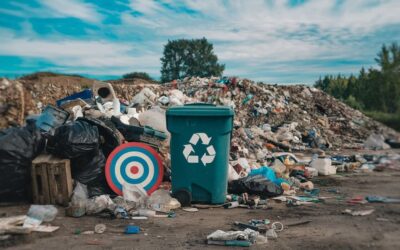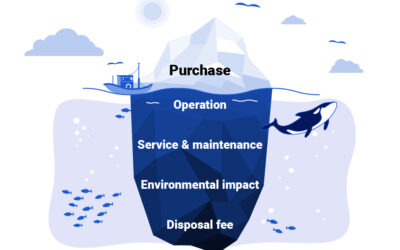The circular economy is a concept that is gaining more and more attention in the world of business and sustainability.
While the traditional economic model is based on a linear system of production and consumption, the circular economy focuses on the efficient use of resources, the reduction of waste and the regeneration of materials.
In this article, we will explore the power of the circular economy and how businesses can adopt it to thrive and save the planet.
Understanding the circular economy: definition and principles
Before delving into the details of the circular economy, it is essential to understand its definition and the principles on which it is based.
The circular economy contrasts with the linear economy, which is based on the production of goods, their use and their disposal.
In contrast, the circular economy aims to create a continuous cycle in which materials are repaired, restored or recycled for use again.
The key principles of the circular economy include extending the life cycle of products, reducing waste, recycling and reusing materials, adopting service-based business models and promoting collaboration between companies.
These principles allow companies to reduce environmental impact, generate economic value and create a more sustainable system.
The advantages of the circular economy
Adopting the circular economy offers numerous benefits for businesses.
First, it reduces dependence on finite natural resources, promoting the efficient and sustainable use of existing resources.
This leads to greater security of supply and a reduction in risks linked to the volatility of raw material prices.
Furthermore, the circular economy can generate new business opportunities and stimulate innovation.
Adopting service-based business models, for example, allows companies to provide more sustainable solutions to their customers, such as leasing or renting products rather than selling them.
Finally, the circular economy contributes to reducing the environmental impact of businesses, making it possible to reduce greenhouse gas emissions, limit waste production and preserve natural ecosystems.
These factors can improve corporate image, attract knowledgeable consumers and increase customer trust.
Examples of successful initiatives in the circular economy
To fully understand the potential of the circular economy, it is useful to look at some examples of successful initiatives.
A well-known example is that of Patagonia, an outdoor clothing company that has adopted a business model based on the restoration and recycling of products.
Patagonia offers free repair programs for its products and promotes recycling through its “Worn Wear” program.
This approach has allowed the company to reduce waste and create a loyal and knowledgeable customer base.
Another example is that of Interface, a leading company in the modular flooring sector.
Interface has taken a holistic approach to the circular economy, focusing on reducing the environmental impact of its products at all stages of the life cycle.
The company has developed a program to recover old floors, uses recycled materials in its production and promotes circular design through collaboration with its suppliers.
Implementation of the circular economy in business operations
Implementing the circular economy into business operations requires a holistic approach and a long-term vision.
Companies must evaluate the entire life cycle of their products, identify opportunities for improvement and adopt more sustainable business models.
Some key strategies include designing for circularity, optimizing materials and waste management, adopting innovative technologies for recycling and reusing materials, and collaborating with other businesses to create circular ecosystems.
It is essential to involve all departments of the company and raise awareness among employees of the importance of the transition towards a circular economy.
Circular economy strategies for different sectors
Circular economy strategies can vary depending on the sector in which a company operates.
For example, in manufacturing, companies can take a products-as-a-service approach, offering customers the opportunity to rent or pay only to use products rather than purchase.
In the food sector, companies can reduce waste by implementing more efficient production practices, promoting the recycling of food waste or developing more sustainable packaging.
In addition, businesses can consider adopting circular economy models at the value chain level, working with suppliers and partners to create a more circular system.
For example, a furniture company might partner with a recycling company to recycle its products at the end of their life.
Overcoming challenges in adopting the circular economy
Adopting the circular economy can present some challenges for businesses.
For example, lack of awareness and knowledge about circular economy opportunities and practices can be an obstacle.
Furthermore, access to the resources and technologies needed to implement the circular economy may be limited.
To overcome these challenges, businesses can invest in employee training and awareness, seek collaborations with experts and organizations specializing in the circular economy, and take a phased approach to implementation, starting with pilot projects to evaluate the effectiveness of the strategies.
Case studies on the circular economy: companies on the front lines
To get inspired and learn from the experiences of companies that have already adopted the circular economy, numerous case studies are available.
A well-known example is that of Philips, a leading company in the lighting sector.
Philips has adopted a business model based on providing lighting services rather than selling lamps. This approach has allowed the company to reduce waste and provide more efficient and economical solutions to its customers.
Another interesting case is that of Unilever, one of the largest consumer goods companies in the world.
Unilever has committed to making its business model more sustainable and has adopted the circular economy as part of its strategy.
The company has implemented packaging recycling programs, reduced manufacturing waste and developed more sustainable products.
This commitment has allowed Unilever to improve its reputation and attract new, knowledgeable customers.
Resources and tools for the circular economy in businesses
For businesses looking to embrace the circular economy, there are numerous helpful resources and tools available.
Organizations like the Ellen MacArthur Foundation offer practical guides, case studies and tools to help businesses transition to a circular economy.
In addition, government funding and incentive programs are available to support businesses that adopt sustainable practices.
Government departments and local environmental organizations can be valuable sources of information and support.
Businesses can consider participating in business networks and communities dedicated to the circular economy, to share knowledge, experiences and best practices.
Conclusions: embrace the circular economy for a sustainable future
The circular economy offers a unique opportunity for businesses to thrive and save the planet.
Through reducing waste, recycling materials and adopting sustainable business models, companies can generate economic value, reduce environmental impact and help create a more sustainable system.
However, adopting the circular economy requires a long-term commitment and a holistic vision.
Businesses must consider the entire lifecycle of their products, identify opportunities for improvement and collaborate with other businesses to create circular ecosystems.
With the help of resources, tools and case studies, businesses can start the transition to a circular economy and help create a sustainable future for all.
Discover how your company can adopt the circular economy to create value, reduce environmental impact and thrive in sustainable business. Contact us today.




